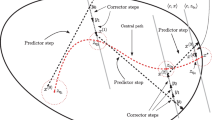Abstract
In this paper, we study iteration complexities of Mizuno-Todd-Ye predictor-corrector (MTY-PC) algorithms in SDP and symmetric cone programs by way of curvature integrals. The curvature integral is defined along the central path, reflecting the geometric structure of the central path. Integrating curvature along the central path, we obtain a precise estimate of the number of iterations to solve the problem. It has been shown for LP that the number of iterations is asymptotically precisely estimated with the integral divided by \(\sqrt{\beta}\), where β is the opening parameter of the neighborhood of the central path in MTY-PC algorithms. Furthermore, this estimate agrees quite well with the observed number of iterations of the algorithm even when β is close to one and when applied to solve large LP instances from NETLIB. The purpose of this paper is to develop direct extensions of these two results to SDP and symmetric cone programs. More specifically, we give concrete formulas for curvature integrals in SDP and symmetric cone programs and give asymptotic estimates for iteration complexities. Through numerical experiments with large SDP instances from SDPLIB, we demonstrate that the number of iterations is explained quite well with the integral even for a large step size which is enough to solve practical large problems.









Similar content being viewed by others
References
Amari, S.-i., Nagaoka, H.: Methods of Information Geometry. Translations of Mathematical Monographs, vol. 191. American Mathematical Society, Providence (2000). Translated from the 1993 Japanese original by Daishi Harada
Borchers, B.: SDPLIB 1.2, library of semidefinite programming test problems. Optim. Methods Softw. 11/12(1–4), 683–690 (1999). Interior point methods
Demmel, J.W.: Applied Numerical Linear Algebra. Society for Industrial and Applied Mathematics (SIAM), Philadelphia (1997)
Faraut, J., Korányi, A.: Analysis on Symmetric Cones. Oxford Mathematical Monographs. The Clarendon Press Oxford University Press, New York (1994). Oxford Science Publications.
Faybusovich, L.: Linear systems in Jordan algebras and primal-dual interior-point algorithms. J. Comput. Appl. Math. 86(1), 149–175 (1997). Special issue dedicated to William B. Gragg (Monterey, CA, 1996)
Kakihara, S., Ohara, A., Tsuchiya, T.: Information geometry and primal-dual interior-point algorithms. Optimization Online (2010)
Kakihara, S., Ohara, A., Tsuchiya, T.: Information geometry and interior-point algorithms in semidefinite programs and symmetric cone programs. J. Optim. Theory Appl. 157(3), 749–780 (2013)
Karmarkar, N.: Riemannian geometry underlying interior-point methods for linear programming. In: Mathematical Developments Arising from Linear Programming (Brunswick, ME, 1988), Contemp. Math., vol. 114, pp. 51–75. American Mathematical Society, Providence (1990)
Monteiro, R.D.C., Adler, I.: Interior path following primal-dual algorithms. I. Linear programming. Math. Program. 44(1, Ser. A), 27–41 (1989)
Monteiro, R.D.C., Tsuchiya, T.: Polynomial convergence of a new family of primal-dual algorithms for semidefinite programming. SIAM J. Optim. 9(3), 551–577 (1999). (electronic)
Monteiro, R.D.C., Tsuchiya, T.: A strong bound on the integral of the central path curvature and its relationship with the iteration-complexity of primal-dual path-following LP algorithms. Math. Program. 115(1, Ser. A), 105–149 (2008)
Monteiro, R.D.C., Zhang, Y.: A unified analysis for a class of long-step primal-dual path-following interior-point algorithms for semidefinite programming. Math. Program. 81(3, Ser. A), 281–299 (1998)
Muramatsu, M.: On a commutative class of search directions for linear programming over symmetric cones. J. Optim. Theory Appl. 112(3), 595–625 (2002)
Ohara, A., Tsuchiya, T.: An information geometric approach to polynomial-time interior-point algorithms: complexity bound via curvature integral. In: Research Memorandum the Institute of Statistical Mathematics, p. 1055 (2007)
Schmieta, S.H., Alizadeh, F.: Extension of primal-dual interior point algorithms to symmetric cones. Math. Program. 96(3, Ser. A), 409–438 (2003)
Sonnevend, G., Stoer, J., Zhao, G.: On the complexity of following the central path of linear programs by linear extrapolation. II. Math. Program. 52(3, Ser. B), 527–553 (1992). 1991. Interior point methods for linear programming: theory and practice (Scheveningen, 1990)
Todd, M.J., Toh, K.C., Tütüncü, R.H.: On the Nesterov-Todd direction in semidefinite programming. SIAM J. Optim. 8(3), 769–796 (1998) (electronic)
Zhao, G., Stoer, J.: Estimating the complexity of a class of path-following methods for solving linear programs by curvature integrals. Appl. Math. Optim. 27(1), 85–103 (1993)
Acknowledgements
The authors are grateful to Professor Renato D.C. Monteiro of the School of Industrial and Systems Engineering, Georgia Institute of Technology, Atlanta, for his insightful discussion about the curvature integral I PD .
Author information
Authors and Affiliations
Corresponding author
Additional information
T. Tsuchiya is supported in part with Grant-in-Aid for Scientific Research (B)20340024 from the Japan Society for the Promotion of Sciences.
Appendix
Appendix
In appendix, we lay out proofs of Lemma 3.5 and Lemma 3.7 used in the proof of Theorem 3.8.
Proof of Lemma 3.5
Let
Then, letting R=W P (w)/ν, we have
Hence, from the continuity of F w , it holds on the neighborhood of the central path that with constants C 1,C 2,
□
Proof of Lemma 3.7
Let
where
Note that by conventions, we allow above formulations of operators and matrices. Then, by Lemma 3.6, we have
We first show that \({\lVert \widetilde{\Delta \mathcal{A}}\rVert }_{F} = \mathcal {O}(\beta^{2})\). We have
Since ∥S∥ F , ∥S ν ∥ F , ∥P∥ F , ∥P ν ∥ F are bounded on \(\mathcal {F}\), and there exists a constant C such that ∥P−P ν ∥ F =C∥w−w c ∥ F and \({\lVert w - w_{c}\rVert }_{F} = \mathcal {O}(\beta^{2})\) from Lemma 3.5, it follows that
Similarly, we have \({\lVert F - F_{\nu}\rVert }_{F} = \mathcal {O}(\beta^{2})\). Thus we obtain
Next, we show \(\lVert \widetilde{\Delta b}\rVert = \mathcal {O}(\beta^{2})\). Similarly, it is easy to see that
The last equality comes from the fact that \({\lVert X^{1/2}SX^{1/2} - \nu I\rVert }_{F} = \mathcal {O}(\beta^{2})\) and ∥P∥ F and ∥X −1/2∥ F are bounded on \(\mathcal {F}\).
Since \(\lVert \widetilde{\mathcal{A}}^{-1}\rVert \), \(\lVert \widetilde{x}\rVert \) are bounded, it follows from above discussion that \(\lVert \widetilde{\Delta x}\rVert = \mathcal {O}(\beta^{2})\), which implies that
□
Rights and permissions
About this article
Cite this article
Kakihara, S., Ohara, A. & Tsuchiya, T. Curvature integrals and iteration complexities in SDP and symmetric cone programs. Comput Optim Appl 57, 623–665 (2014). https://doi.org/10.1007/s10589-013-9608-x
Received:
Published:
Issue Date:
DOI: https://doi.org/10.1007/s10589-013-9608-x




